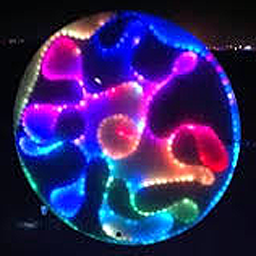10#define COLOR_ORDER GRB
81#define TWINKLE_SPEED 4
86#define TWINKLE_DENSITY 5
89#define SECONDS_PER_PALETTE 30
105#define AUTO_SELECT_BACKGROUND_COLOR 0
110#define COOL_LIKE_INCANDESCENT 1
122 chooseNextColorPalette(gTargetPalette);
129 chooseNextColorPalette( gTargetPalette );
153 uint16_t PRNG16 = 11337;
155 uint32_t clock32 = millis();
162 if( (AUTO_SELECT_BACKGROUND_COLOR == 1) &&
163 (gCurrentPalette[0] == gCurrentPalette[1] )) {
164 bg = gCurrentPalette[0];
168 }
else if( bglight > 16) {
174 bg = gBackgroundColor;
179 for(
CRGB& pixel: L) {
180 PRNG16 = (uint16_t)(PRNG16 * 2053) + 1384;
181 uint16_t myclockoffset16= PRNG16;
182 PRNG16 = (uint16_t)(PRNG16 * 2053) + 1384;
184 uint8_t myspeedmultiplierQ5_3 = ((((PRNG16 & 0xFF)>>4) + (PRNG16 & 0x0F)) & 0x0F) + 0x08;
185 uint32_t myclock30 = (uint32_t)((clock32 * myspeedmultiplierQ5_3) >> 3) + myclockoffset16;
186 uint8_t myunique8 = PRNG16 >> 8;
191 CRGB c = computeOneTwinkle( myclock30, myunique8);
194 int16_t deltabright = cbright - backgroundBrightness;
195 if( deltabright >= 32 || (!bg)) {
199 }
else if( deltabright > 0 ) {
202 pixel =
blend( bg, c, deltabright * 8);
221CRGB computeOneTwinkle( uint32_t ms, uint8_t salt)
223 uint16_t ticks = ms >> (8-TWINKLE_SPEED);
224 uint8_t fastcycle8 = ticks;
225 uint16_t slowcycle16 = (ticks >> 8) + salt;
226 slowcycle16 +=
sin8( slowcycle16);
227 slowcycle16 = (slowcycle16 * 2053) + 1384;
228 uint8_t slowcycle8 = (slowcycle16 & 0xFF) + (slowcycle16 >> 8);
231 if( ((slowcycle8 & 0x0E)/2) < TWINKLE_DENSITY) {
232 bright = attackDecayWave8( fastcycle8);
235 uint8_t hue = slowcycle8 - salt;
239 if( COOL_LIKE_INCANDESCENT == 1 ) {
240 coolLikeIncandescent( c, fastcycle8);
259uint8_t attackDecayWave8( uint8_t i)
265 return 255 - (i + (i/2));
272void coolLikeIncandescent(
CRGB& c, uint8_t phase)
274 if( phase < 128)
return;
276 uint8_t cooling = (phase - 128) >> 4;
278 c.
b =
qsub8( c.
b, cooling * 2);
290#define Holly_Green 0x00580c
291#define Holly_Red 0xB00402
293{ Holly_Green, Holly_Green, Holly_Green, Holly_Green,
294 Holly_Green, Holly_Green, Holly_Green, Holly_Green,
295 Holly_Green, Holly_Green, Holly_Green, Holly_Green,
296 Holly_Green, Holly_Green, Holly_Green, Holly_Red
316#define HALFFAIRY ((CRGB::FairyLight & 0xFEFEFE) / 2)
317#define QUARTERFAIRY ((CRGB::FairyLight & 0xFCFCFC) / 4)
326{ 0x304048, 0x304048, 0x304048, 0x304048,
327 0x304048, 0x304048, 0x304048, 0x304048,
328 0x304048, 0x304048, 0x304048, 0x304048,
329 0x304048, 0x304048, 0x304048, 0xE0F0FF };
333#define C9_Red 0xB80400
334#define C9_Orange 0x902C02
335#define C9_Green 0x046002
336#define C9_Blue 0x070758
337#define C9_White 0x606820
339{ C9_Red, C9_Orange, C9_Red, C9_Orange,
340 C9_Orange, C9_Red, C9_Orange, C9_Red,
341 C9_Green, C9_Green, C9_Green, C9_Green,
342 C9_Blue, C9_Blue, C9_Blue,
347#define Ice_Blue1 0x0C1040
348#define Ice_Blue2 0x182080
349#define Ice_Blue3 0x5080C0
352 Ice_Blue1, Ice_Blue1, Ice_Blue1, Ice_Blue1,
353 Ice_Blue1, Ice_Blue1, Ice_Blue1, Ice_Blue1,
354 Ice_Blue1, Ice_Blue1, Ice_Blue1, Ice_Blue1,
355 Ice_Blue2, Ice_Blue2, Ice_Blue2, Ice_Blue3
378 const uint8_t numberOfPalettes =
sizeof(ActivePaletteList) /
sizeof(ActivePaletteList[0]);
379 static uint8_t whichPalette = -1;
380 whichPalette =
addmod8( whichPalette, 1, numberOfPalettes);
382 pal = *(ActivePaletteList[whichPalette]);
CFastLED FastLED
Global LED strip management instance.
central include file for FastLED, defines the CFastLED class/object
void show(uint8_t scale)
Update all our controllers with the current led colors, using the passed in brightness.
void setMaxPowerInVoltsAndMilliamps(uint8_t volts, uint32_t milliamps)
Set the maximum power to be used, given in volts and milliamps.
static CLEDController & addLeds(CLEDController *pLed, struct CRGB *data, int nLedsOrOffset, int nLedsIfOffset=0)
Add a CLEDController instance to the world.
A version of CPixelView<CRGB> with an included array of CRGB LEDs.
RGB color palette with 16 discrete values.
uint32_t TProgmemRGBPalette16[16]
CRGBPalette16 entries stored in PROGMEM memory.
#define FL_PROGMEM
PROGMEM keyword for storage.
CRGB blend(const CRGB &p1, const CRGB &p2, fract8 amountOfP2)
Computes a new color blended some fraction of the way between two other colors.
@ TypicalLEDStrip
Typical values for SMD5050 LEDs.
LIB8STATIC uint8_t addmod8(uint8_t a, uint8_t b, uint8_t m)
Add two numbers, and calculate the modulo of the sum and a third number, M.
LIB8STATIC_ALWAYS_INLINE uint8_t qsub8(uint8_t i, uint8_t j)
Subtract one byte from another, saturating at 0x00.
void nblendPaletteTowardPalette(CRGBPalette16 ¤t, CRGBPalette16 &target, uint8_t maxChanges)
Alter one palette by making it slightly more like a "target palette".
CRGB ColorFromPalette(const CRGBPalette16 &pal, uint8_t index, uint8_t brightness, TBlendType blendType)
Get a color from a palette.
@ NOBLEND
No interpolation between palette entries.
const TProgmemRGBPalette16 PartyColors_p
HSV color ramp: blue, purple, pink, red, orange, yellow (and back).
const TProgmemRGBPalette16 RainbowColors_p
HSV Rainbow.
#define EVERY_N_MILLISECONDS(N)
Alias for EVERY_N_MILLIS.
#define EVERY_N_SECONDS(N)
Checks whether to execute a block of code every N seconds.
#define sin8
Platform-independent alias of the fast sin implementation.
Representation of an RGB pixel (Red, Green, Blue)
FASTLED_FORCE_INLINE CRGB & nscale8_video(uint8_t scaledown)
Scale down a RGB to N/256ths of it's current brightness using "video" dimming rules.
uint8_t g
Green channel value.
FASTLED_FORCE_INLINE uint8_t getAverageLight() const
Get the average of the R, G, and B values.
uint8_t b
Blue channel value.

